This post may contain affiliate links. Please read my disclosure for details at the bottom of this page. As an Amazon Associate, I earn from qualifying purchases on this Korean fruit article. We hope you enjoy this beginners guide to Korean fruit!
Published 07/15/2021 Updated 02/01/2023
In South Korea, popular fruits from across the globe (such as oranges, strawberries, and bananas) are imported and commonly available. Unfortunately, many native fruits of South Korea are often exported or grown nearly as much in other countries and continents. In this article, I list some popular types of fruits grown in South Korea. While some of these fruits are easy to find, others you may need to hunt for outside of South Korea.
I hope you enjoy this list of different Korean fruits. If I left some of your favorites off this list, let me know in the comment section below!
A Beginners Guide to Korean Fruit:
Below, I listed some common local Korean fruits. As I stated above, if I do not list your favorite Korean fruit, feel free to leave a comment or email me at [email protected].
1. Korean Melon: Chamoe (참외)
The Korean melon, also known as the oriental melon, is a bright yellow and striped melon grown primarily in South Korea. Known as ‘chamoe’ (참외) in Korea, people often describe these fruits as tasting like a mix between a honeydew melon and a cucumber. They also say that these fruits taste similar to a pear.
In South Korea, the chamoe melon is often extremely cheap (unlike some other fruits like high-end expensive apples). You can find it in grocery stores as well as street markets. I recommend enjoying this fruit sliced and fresh on a nice, warm, and sunny day.
Learn more about this ingredient via my Korean ingredient article on this fruit!
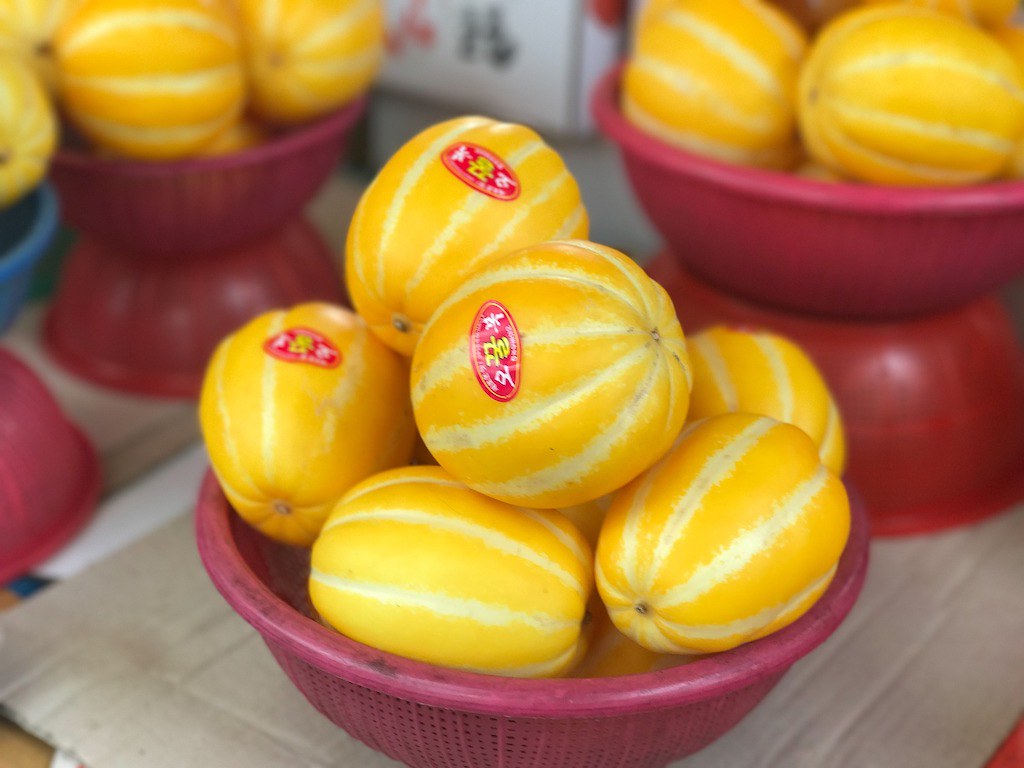
Korean Melons Look Unique, Right?!
2. Korean Pear: Bae (배)
The Korean pear, otherwise known as an Asiatic, Japanese, or Chinese pear, is a large, round pear grown across Asia. Known as ‘bae’ (배) in Korean, people describe these fruits as tasting like a mix between a pear and an apple. Actually, some people often refer to this pear as the ‘apple-pear’ because of its crisp, crunchy, juicy texture and flavor.
In South Korea, people serve these pears fresh in slices. Also, they use these pears as an ingredient while cooking! Most famously, they use it in bulgogi. The pear acts as a sweetener as well as a softening agent for the tough, well-cooked meat.
Learn in about Korean pears in-depth in my article about Asian pears in Korean cuisine.
Korean Pear Fact: In South Korea, the people in the city of Naju famously grow these pears. As such, the city has the ‘Naju Pear Museum’ as well as pear orchards open to tourists and the general public.
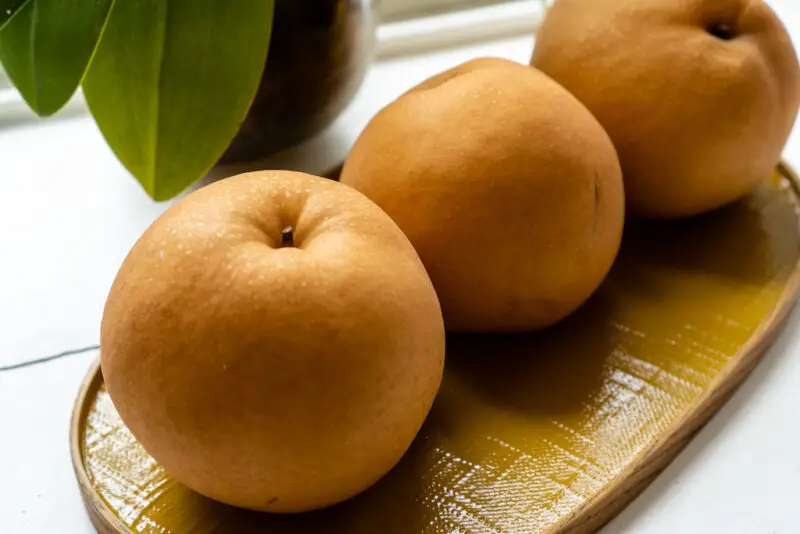
3. Green Plums: Maesil (매실)
Korean green plums, also known as the Chinese plum or Japanese apricot, are small green fruits grown on a type of East Asian plum blossom tree. Across Asia, people use these fruits in different traditional and cultural cooking methods. In South Korea, they are used to make items such as honey plum tea and Korean plum syrup!
People in Korea believe these plums have health benefits such as boosting digestion and promoting high energy.
Learn in about green plums in-depth in our article: ‘Green Plums in Korean Cooking (Maesil).’

Green Plums on the Tree.
4. Persimmon: Gam (감)
The persimmon is a type of bright orange fruit grown and cultivated in the fall months. Persimmons have a honey-like flavor that is both sweet and rich. While grown in most East Asian countries, people in South Korea typically enjoy this fruit in three different ways.
In Korea, people eat persimmons fresh, after being preserved for 3-5 days, or completely dried after removing the skin. Also, people use these fruits to make traditional teas and drinks!
If you do visit Korea in the fall, you will often see persimmons hanging to dry outside of people’s traditional homes.
Learn in about persimmons in-depth in my article: ‘A Guide to Persimmons in Korean Cuisine.’
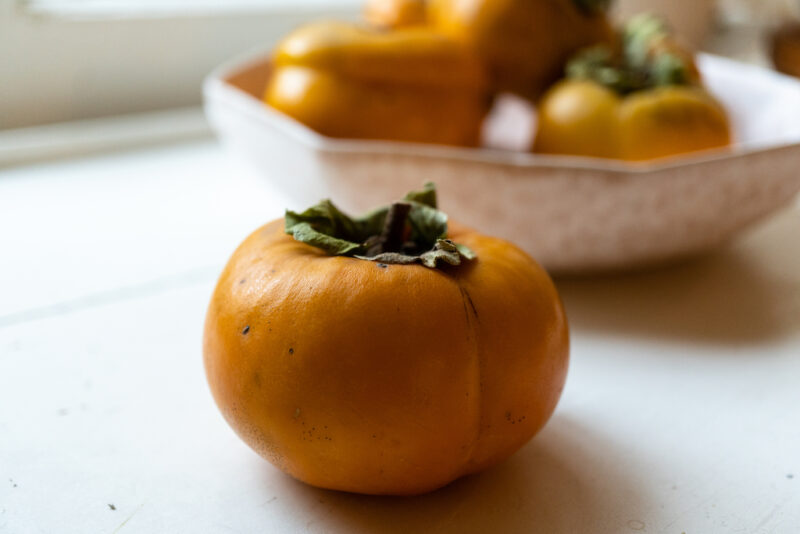
5. Yuzu: Yuja (유자)
The yuzu fruit is a type of citrus that looks like a small grapefruit. The skin looks uneven and yellow when ripened. The distinctive flavor is a mix between lemon, grapefruit, and lime.
In Korean cuisine, people use yuja to make yuja cheong, a type of thick marmalade used in tea. Also, they eat it fresh and use it in varieties of hwachae, a type of fruit punch.
Unfortunately, you will not find this fruit available in most grocery stores in the United States. It is illegal to import yuzu. While it is illegal to import, some trees were introduced to the United States in the 1800s. As such, growers can sell the fruit from the trees in the U.S. If you do find a yuzu, you may be surprised by the cost–they can be very expensive because of the scarcity!

Where Can I Buy Yuzu Fruit?
6. Hallabong (한라봉)
Hallabong is a type of Korean citrus hybrid grown and cultivated on Jeju Island. While these fruits are a type of tangerine, they look more similar to the standard orange. This fruit has a high sugar content, a soft and juicy texture, and a sweet and sour flavor.
In South Korea, it is popular to use this fruit in fancy cafe drinks and sweet desserts! Currently, this citrus hybrid is still mainly grown and eaten in South Korea. If you ever get the chance, definitely try it!
Learn in about hallabong in-depth in my ingredient article about this Korean citrus fruit!
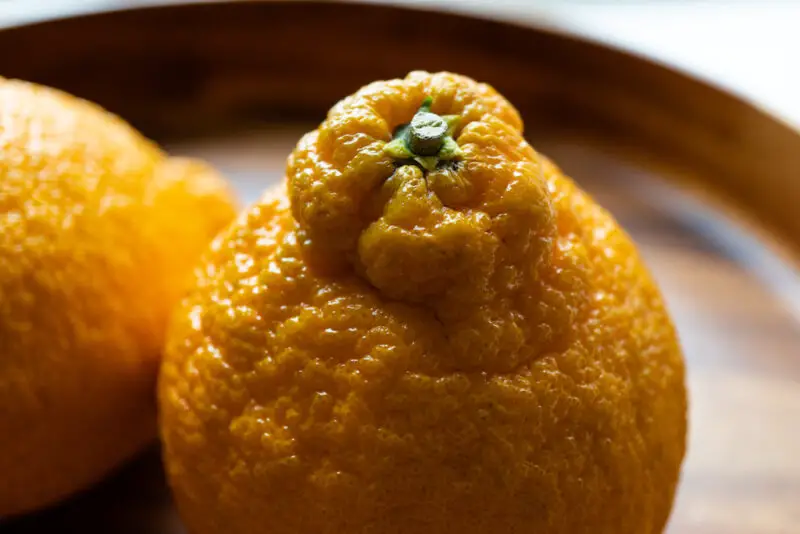
7. Tangerine: Gyul (귤)
The tangerine fruit is a popular type of citrus that is available all across the globe. While that may be the case, most people have not tried a tangerine grown on Jeju Island in South Korea.
The most common type of tangerine on Jeju Island is of the Noji variety. These fruits naturally grow on the island, so they need limited cultivation and care. The resulting tangerines are sweet and soft. The burst of flavor is beyond anything you may get in a grocery store outside of Korea! Interestingly, many experts say the weather in Jeju makes it the most perfect location in the world to grow tangerines.
Yes, they are that good.

Tangerines!!!
8. Korean Blackberry: Bokbunja (복분자)
The bokbunja, also known as the Korean blackberry or the Korean bramble, is a type of blackberry native to South Korea, China, and Japan. South Koreans use these wild and cultivated berries are commonly to produce fermented Korean fruit wine known as ‘bokbunja ju.’
If you travel to South Korea or have a chance to shop at an Asian grocery store, I recommend buying some blackberry wine to try!
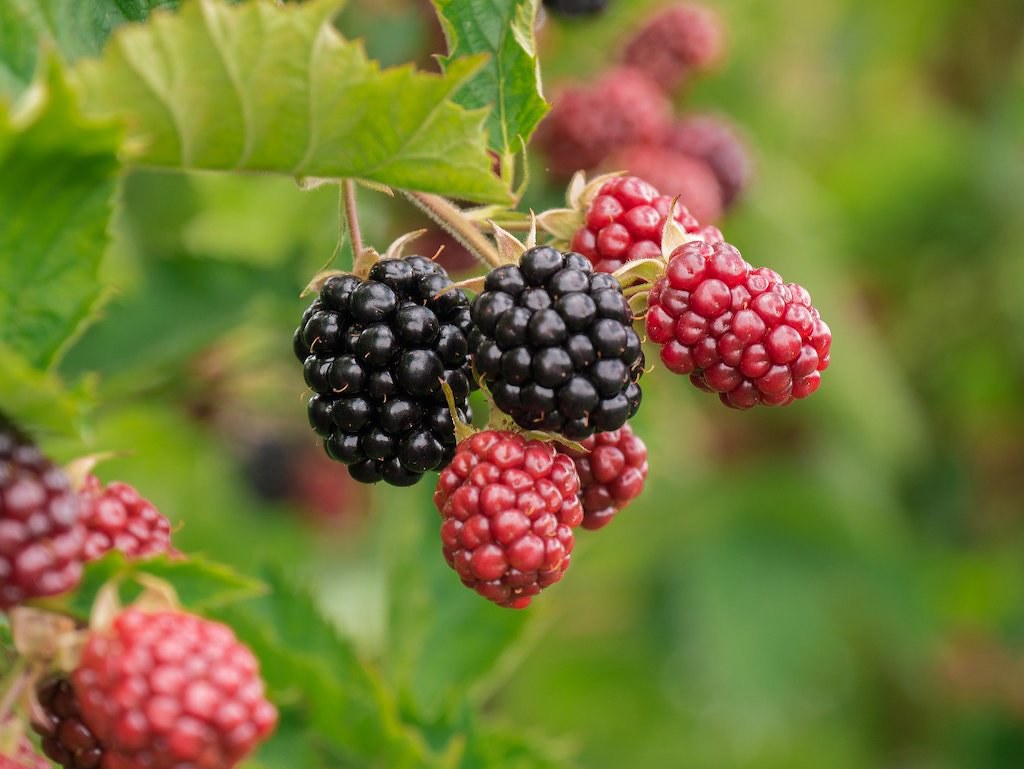
These Are Normal Blackberries, the Korea Variety Look Slightly Different
9. Magnolia Berry: Omija (오미자)
The magnolia vine is a type of plant native to Northern China, the far eastern part of Russia, and the Korean peninsula. The plant produces a type of berry known as the ‘five flavor fruit’ in both China and Korea. These fruits are bright red. The name ‘five flavor fruit’ comes from the fact that the berries possess five different flavor profiles: salty, sweet, sour, pungency, and bitter.
In Korea, they use these berries to make a tea known as ‘omija cha.’
Learn more about this ingredient via my ingredient article on the subject!
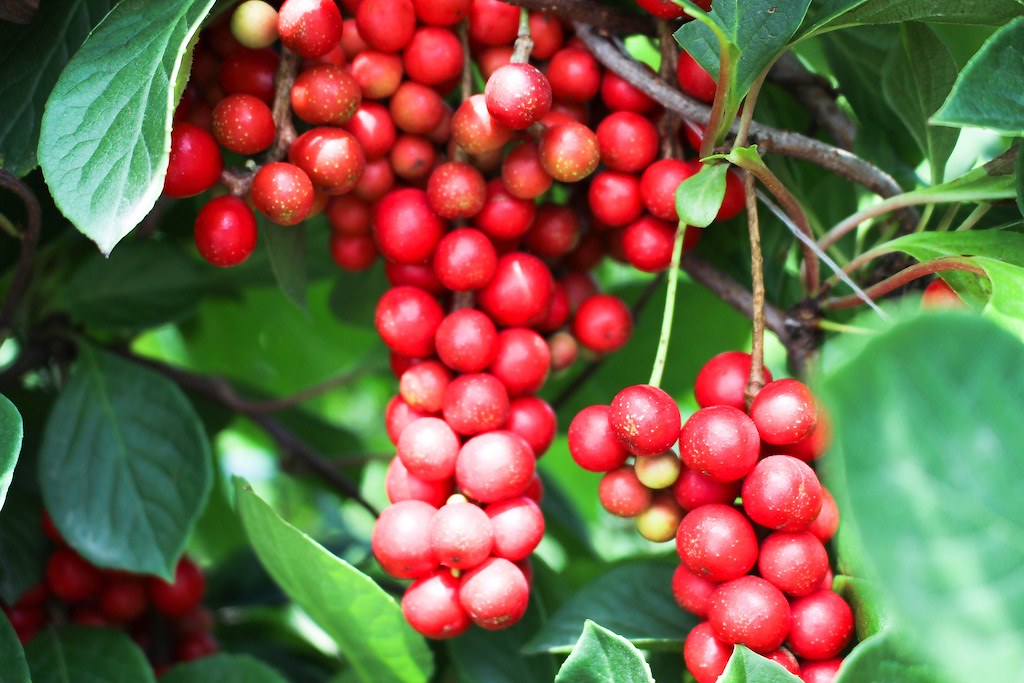
Are You Curious About the Flavor?
10. Apples: Sagwa (사과)
While apples grow all across the globe, apples in Korea are culturally connected to major holidays. As such, they are often extremely expensive. At certain times of the year, such as the period around Chuseok, fancy boxes of apples start showing up in the grocery store. In Korea, people buy these specialty apple boxes to give as gifts. While the price of these apples vary, you can usually expect to spent around 100 dollars.
Beyond consumerism, one of the reasons why these apples are so expensive is that they grown domestically in South Korea. Around Chuseok, local apple growers harvest the apples from the trees. These particular apples are known as ‘hongno apples.’ Famously, the majority are harvested in the Jangsu district of South Korea.
Fun Apple Fact: In the Korean language, ‘I’m sorry’ is the same word for ‘apple.’ As a result, people often give friends and family apples when apologizing!

Cute Apple Bread in Korea. The Hangul Means ‘Apple.’
Concluding a Beginners Guide to Korean Fruit:
In the end, I hope you enjoyed learning about Korean fruit. Also, I may expand on this list in the future. If you enjoyed learning about Korean fruit, let me know in the comment section below. I would love to hear about your favorites!
If you would like to read more about cooking, you can find recipes on this blog. Below, I listed some of our favorite Carving A Journey Korean recipes! For reference, many recipes are influenced by our blended Korean and Southern heritage.
Carving A Journey Korean Recipes:
- Tteokkochi (Korean Rice Cake Skewers)
- Jumeokbap (Handmade Korean Rice Balls)
- Strawberry Matcha Latte Recipe
- Soju Caipirinha (A Korean Take on Brazil’s National Drink)
- Bibimmyeon (Korean Spicy Cold Noodles)
- Korean Strawberry Milk Recipe
- Brown Sugar Iced Latte (Korean Burnt Sugar Latte); And
- Korean Banana Flavored Milk
If you have any questions or comments, you can also email me at [email protected].
And, finally, I would love to hear from you through my social media as well! You can follow me at @carvingajourney on Instagram, Twitter, Facebook, and Pinterest. Or, if you would like more articles like these, you can subscribe to my blog by joining my mailing list. I hope you enjoyed reading about different types of Korean fruit! Thank you so much for stopping by!
Carving A Journey is a participant in the Amazon Services LLC Associates Program, an affiliate advertising program designed to provide a means for sites to earn advertising fees by advertising and linking to Amazon.com. Although we may earn commissions for our endorsement, recommendation, testimonial, and/or link to any products or services from this website, these opinions are my own and I fully support these products.

